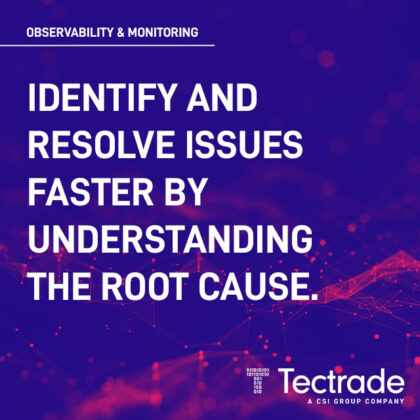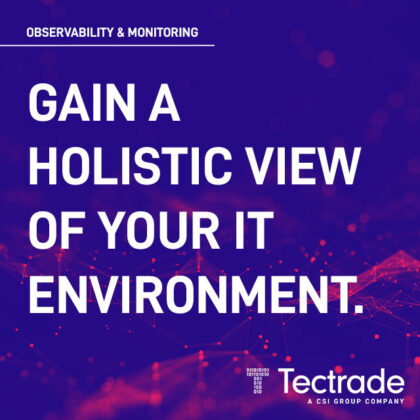Observability and Monitoring: Why have both?
Time to read: 10 mins
It’s essential to have visibility into the health of complex IT systems, otherwise you will run into problems you could have avoided or remedied sooner.
Performance can be monitored using tools to collect metrics and log data from servers, applications, networks, and devices – but is that enough to ensure the reliability, security, and efficiency of your critical systems?
This article looks at the difference between observability and monitoring– and why organizations should adopt both for a holistic view of their IT environment.
We’ll also explore how Tectrade can help you achieve observability with a cloud-based platform that integrates monitoring, alerting, analytics, and automation.
What is Monitoring?
Monitoring checks the progress or quality of your IT systems over time and keeps them under systematic review. It collates data to display in dashboards or reports to help answer questions like:
- Do we have any errors in the system?
- How many requests is the web server processing?
- What is the average response time of the database?
- How much CPU and memory do the applications consume?
- How much bandwidth does the network consume?
To avoid impacting users or customers, monitoring helps detect problems before they cause issues. The data collected from the logs provides historical context as to what happened.
The downside with monitoring is that it only analyzes what is happening based on predefined metrics and thresholds; not why something is happening or how to rectify the issue.
Monitoring can’t account for unknown or unexpected events that may affect IT systems – but good news, that’s where observability comes in.
So, what is Observability?
Observability helps you understand the condition of your IT systems based on reading data from the external outputs. It aids with faster problem identification and resolution by answering questions like:
- What are the root causes and impacts of errors in the system?
- What caused the web server to crash?
- What caused the spike in the response time of the database?
- How does CPU and memory usage impact application performance?
- How does network latency impact the user experience?
Observability aids in the discovery of anomalies or unknowns impacting your IT systems and helps interpret the behaviour and interactions across different layers and domains.
Observability works by analysing data from multiple sources and perspectives using AI and machine learning. Then it creates actionable insights to assist in the optimization or improvement of your systems.

Why are both Observability and Monitoring advised?
To gain a universal picture of your IT environment, you need to utilise observability and monitoring concurrently.
Where monitoring collects data from systems, it effectively provides a baseline for the observability engine – otherwise the results would be very limited.
On the other hand, observability provides deeper insights beyond monitoring data alone – and those results could be incomplete or superficial with the additional intelligence.
Benefits for IT Operations by combining monitoring and observability:
- Quicker problem detection and resolution
- Improved root cause analysis & impact assessment
- Optimized system performance and enhanced efficiency
- Better user experience and satisfaction
- Increased business value and innovation
How Tectrade Can Help You Enhance Observability
To help clients gain a holistic understanding of complex IT environments, we use a leading cloud-based observability platform that combines monitoring, alerting, analytics, and automation into a single solution.
With Tectrade we can help you achieve:
Data Collection: scan thousands of data sources across hybrid cloud environments using agentless methods including metrics, logs, traces, events, configurations, topologies, and more.
Data Analysis: AI and machine learning provides enhanced anomaly detection, root cause analysis, dynamic thresholds, forecasting, correlation, etc.
Data Visualization: customizable dashboards and reports for real-time visibility into system health and performance.
Data Action: execute scripts based on alert conditions (e.g. scale up/down resources), and trigger alerts from predefined rules or dynamic conditions to notify relevant stakeholders through various communication channels.

In Summary: Observability vs Monitoring
Modern IT Operations teams need both observability and monitoring to gain a complete picture of an IT environment.
Observability aids with faster problem identification and resolution. It gives you knowledge of what is happening, and more importantly why it happened and what caused the issue.
Monitoring gives you the intelligence to detect problems before they cause issues. It allows you to collate data and manipulate it using dashboards and reports to assess trends and metrics.
To find out how Tectrade can help IT Ops enhance the observability of your systems, get in touch with our technicians today.
Read more articles

Storage and Backup
A Buying Guide to Finding the Best Storage Solution for Your Business
Find the right storage solution for your company.
IBM Power
The IT Skills Gap Is Only Getting Wider in 2024
The IT skills gap is forecasted to widen in 2024 – especially for IBM i skills, what happens next?

About Tectrade
Tectrade Change Freeze (Dec-Jan)
We will be operating a ‘Change Freeze’ across our hosted and managed infrastructure to manage risk at this critical time.